
Pages:
<< Back 1
2 3 4
5 6 7
8 9 10
Next >>
At the same time the administration replaced the former position
of preceptress of Ladies' Hall with that of dean of women, assigned
on a part-time basis first to Rose F. Laitem of the department of
Romance languages and then to Bessie M. Smith of the School of Art.
The two women's dormitories, Ladies' Hall, usually known simply
as "The Dorm," and Florence Hall, converted from a rooming
and boarding facility for men, were placed under the management
of Lucy Black, who may be considered the first director of residence
halls. Men continued to live out in town, either in rooming houses
or fraternity chapter houses, but many of them joined the women
students at the coeducational dining tables in the halls. Other
non-residence diners in the dormitories included single faculty
members and sorority women living in chapter houses.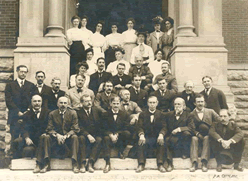
____________________________________________
Most of the DePauw faculty gathers on the steps of East College in
1907. Front row, from left: J. Dobell, H.B. Longden, H.J.
Banker, E. H. Hughes, H.A. Gobin, J.P. Naylor, W.M. Blanchard, A.
Schellschmidt; second row: H.B. Gough, W. T. Ayres, W.V. Brown, A.
Stephenson, F.E. Watson, E. Post, N.W. Barnes, A.M. Brown, W.G.
Seaman, W.M. Hudson. Third row: A.V. McCoy, R.B. von KleinSmid,
R. Baker, J.R. Weaver, A.F. Caldwell. Fourth row: Margaret Overbeck,
Belle Mansfield, B.N. Smith, M.M. Kern. Fifth row: R.M.
Rutledge,
M.M. Zabriskie, D.B. Shearer, R. Laitem, unidentified, E.P. Sawyers, and J. Druley.
____________________________________________

___________________________________
The academic procession is led by the
faculty on its way to Meharry Hall during the
McConnell administration. The memorial
gateway at Anderson and Locust had not
yet been built.
__________________________________
The faculty still took on a variety of non-teaching tasks, despite
the general tendency toward specialization. For example, the titular
librarian was usually a professor, even though most of the actual
operation of the library was carried on by an assistant engaged for
that purpose, the first of whom was Martha B. Longden. Margaret
Gilmore began her long career in that role in 1908, just in time to
help organize the move to the new Carnegie Library on College
Avenue. The office of the registrar grew in importance in these
years, its duties assigned to Joseph T. Dobell, an instructor in
mathematics at the Academy, the new name of the preparatory school
after 1896.
 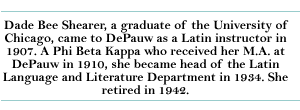
Some
professors took on a wide variety of chores outside the classroom.
A striking case is that of Rufus B. von KleinSmid the colorful professor
of education and principal of the Academy who coached fencing, directed
the men's glee club, and put on an annual minstrel show and other
stage performances! Moreover, most members of the faculty carried
heavy teaching loads, with little opportunity for scholarly production.
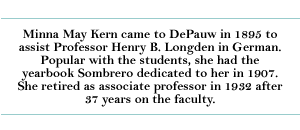
President
McConnell, who showed a special concern for the faculty, did initiate
a rudimentary system of sabbaticals in 1910, but they did not become
a general institutional practice for many years.
Most academic departments remained the domain of a single full professor,
often with an instructor or assistant professor added in these years
to help with the increased student enrollments. The growth in subject
areas within an elective system curriculum also brought about expansion
of the departmental organization. Separate departments of English
composition and rhetoric, English literature, comparative literature,
and public speaking and debate came into
existence, headed respectively by Nathaniel W. Barnes, Adelbert
F. Caldwell, Francis C. Tilden, and Harry B. Gough.
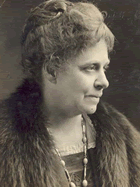 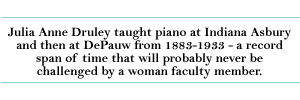
In
1906 the indefatigable KleinSmid expanded the department of education
to the department of education and psychology, which began to offer
specialized training for careers in secondary teaching and administration.
The social sciences finally came into their own, with the separation
of sociology from Colonel James R. Weaver's political science department
in 1908 and economics in 1912, made possible by the appointment
to the faculty of Cecil C. North and Frank H. Streightoff.
The curriculum also underwent considerable reorganization at this
time. In 1903 the course was replaced by the credit hour as the
basic unit of study, meaning one hour of class work per week for
each of the three terms into which the academic calendar was then
divided. A minimum of 180 hours, or an average of 15 hours per week
for each of the 12 terms, was required for graduation. The major
consisted of 36 hours in one department, and the minor was dropped.
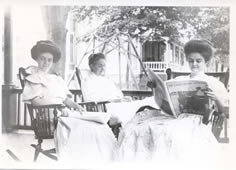 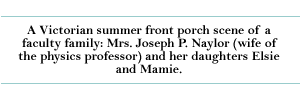
Graduation requirements, divided into four groups, included 24 hours
in a foreign language, 12 in science, six in mathematics, three
in rhetoric, three in Bible, and six in physical education. For
the first time there was no absolute requirement in philosophy,
but students had to choose 12 hours in either history, political
science, or philosophy. Two years later the faculty voted to eliminate
the bachelor of philosophy and science degrees as no longer applicable
to the new set of graduation requirements, and in future years to
offer only a bachelor of arts degree in the College of Liberal Arts.
In 1910 a major shift was made from the three-term to a two-semester
plan, with 120 semester hours now required for graduation and 24
hours for a major.
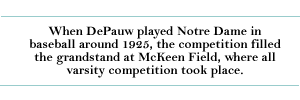
The
growing importance of organized sports at DePauw was signalled in
1903 by the creation of an Athletic Board consisting of the University
president, three faculty members, and three students. Financial
support derived from student fees and an annual fundraising carnival.
The first athletic letter "Ds" were awarded in 1905 and
a "D" Association formed two years later.
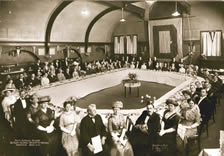 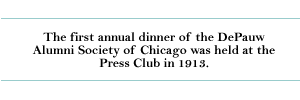
The
joint board of trustees and visitors in which the original Indiana
Asbury charter had vested the general oversight of the University
promulgated an important change in its membership in 1909. Taking
advantage of a 1907 enactment by the Indiana General Assembly, the
board amended the charter to increase the number of trustees from
25 to 35, of which 21 were elected by the three Indiana conferences
of the Methodist Episcopal Church, 10 by the board itself, and four
by the Society of the Alumni. The nine visitors named by the Indiana
Methodist conferences remained, though their role had been declining
for some time. The chief significance of this change was to provide
for representation on the board by DePauw alumni, a measure long
sought by many of their number. But the effect was also to modify
slightly the institution's affiliation to the Indiana Methodist
conferences, which had hitherto named all members of the board.
 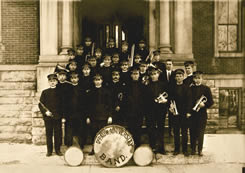
Back
to Top
Pages:
<< Back 1
2 3 4
5 6 7
8 9 10
Next >>
|
















